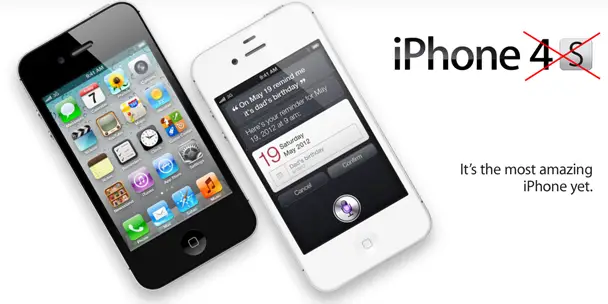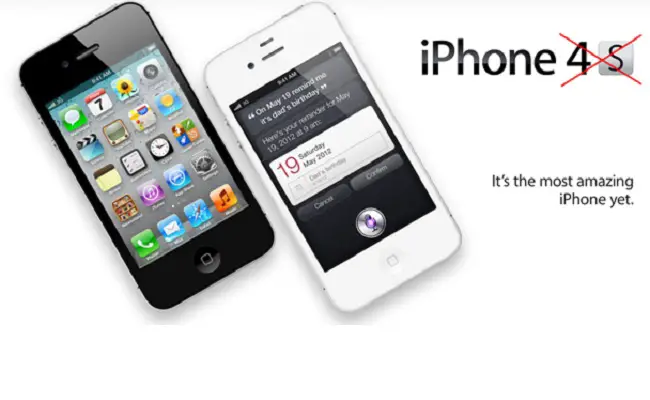What will the next iPhone be named?

These days the news are full of leaks, speculations, and other stories about the iPhone 5. Aside from having no interest in the iPhone, these stories bug me because of one simple reason: The iPhone 5 was released last year, at least if you’re referring to the fifth iteration of the iPhone. And this confusion is just the tip of the iceberg when it comes to Apple’s naming scheme.
The iPhone 4S is the iPhone 5 in the mathematical sense. The original iPhone was the first iPhone, and as such, its name didn’t require a number or additional designation. The iPhone 3G was a confusing device, because in referring to the data speed (3G) in the same way that you could refer to the third generation of something, it suddenly became a bit unclear which number it was. The iPhone 3GS was a clever- but in hindsight probably unintentional- way of “resetting” the naming scheme so that the iPhone 4 could be released with the name being the actual generation number. Then Apple broke it again with the iPhone 4S, actually offsetting the naming scheme in the exact opposite direction of what the 3GS did.
Now, Apple is set to release another iPhone. People refer to it as the iPhone 5, but it isn’t really. It’s the sixth iPhone, so if anything, it’s the iPhone 6. Some might argue that Apple’s naming scheme is independent of the generation number, in much the same way that Microsoft’s Windows 8 is very far from being the 8th version of Windows, but if that’s the case, it will be the first time Apple does that with the iPhone line. After all, if the iPhone 4S doesn’t count as an entirely new iPhone, the same logic would mean that the iPhone 3GS didn’t count as an entirely new iPhone. If that was the case, the iPhone 4 should have been called the iPhone 3, and, well, it wasn’t.
If you ask me, Apple is not going to number nor name the new iPhone. Instead, it will simply be “the new iPhone.” That’s what it did with the iPad 3, and that’s also close to how it’s been naming other products. In fact, the iPhone is the only Apple product currently being sold that has a name/number added to its base name. You might find references to generation number or relevant features, but for all intents and purposes, Apple sells the iPod touch, iPod classic, iPod nano, iPod shuffle, MacBook Air, Apple TV, and so on and so fourth – without ever referring to which version it is in the main name.
Operating without names or version numbers to distinguish one product from last year’s product makes it very hard to keep track of what model a device is, and the iPhone and iPad are the only two Apple products that I know the version number of without a Google search. In many ways though, those are also the two Apple products that have changed the most in recent years. Even with the introduction of a high resolution display on the MacBook Pro, I think most people would look at a lineup of iterations going back a few years and simply classify it as “a group of MacBook Pros.” The same can be said for many other Apple products, and there is definitely diminishing returns for upgrading these things.
With the iPad 3’s release, that’s also becoming true of the iPad line. I’m not the only one who is in no hurry to upgrade from the iPad 2, simply because the functionality is practically identical even if the screen resolution is noticeably lower. The iPad 1 was under-equipped in the RAM-department to the point that it should frankly never have been released in that condition, but between the iPad 2 and the iPad 3, there’s much less of a difference in what it can do- it’s more about how well it looks while doing it.
That is also true of the last couple of iPhones, and the resolution, speed, camera, and RAM increase from the 3GS to the iPhone 4 was much more important that what changed from the iPhone 4 to the 4S. I think the same will be true for the next iPhone as well, and aside from the rumors of a different screen ratio, I don’t think many are expecting it to be that big of an upgrade from the iPhone 4S. We’re getting to the point where smartphone upgrades are starting to resemble computer upgrades, with all the features being better to some degree but without anything truly revolutionary being introduced. It therefore makes sense to stop treating iPhone and iPad upgrades as that much more special than upgrades to other products, and therein lies the change in naming scheme that we’ve already seen with the 3rd iPad, and probably (if you ask me) will see with the 6th iPhone.
My biggest issue with Apple’s naming scheme is that it makes it hard to search for information on a specific product. A couple of years from now, how do you tell the difference between an iPad 3, 4, and 5, if all of them are called “the new iPad.”? Here in Norway, many stores are extremely sloppy and slow when it comes to keeping track of new Apple products. Devices are also often released later, so people might read about an update to an Apple product and then go buy the old version at the local electronics store. Some stores and chains are also borderline deceptive in the way they sell old models as new even after the release of new models, and there are even cases of iPad 2s being sold next to iPad 3 advertisement posters. So many people that can’t tell the difference buy these types of products now that it’s more important than ever to educate people on what device they’re buying. Not because it will necessarily matter to many people if they have one generation or another, but simply because you should get what you pay for, not what people paid for last year.
If it hadn’t been for this confusion, I would have preferred Apple’s naming scheme over that of e.g. Samsung. I’m not one to upgrade my devices that often, and even though I very much doubt that Apple’s intention with this is to extend the expected life cycle of a product, one can always hope that it will happen as a result of differentiating between devices less.
It’s hard to try to interpret exactly what Apple is doing with the way it’s naming its products. It’s probably based on some marketing ploy, but what the exact reason is I don’t know. Perhaps the brands are stronger if everyone refers to the various generations under the same name, or perhaps there’s a mental association with the word “new” that is worth more than model numbers. All I know is that the 6th version of the iPhone is due to be announced this fall, and right now, the iPhone is the only Apple product that has a generation-specific name. At the end of the day, it doesn’t really matter, but the same can be said for so many things that I might as well bring it up.


